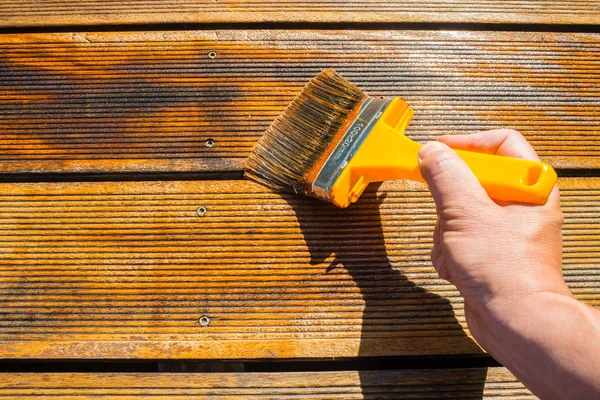Transform Your Outdoor Space: The Ultimate Guide To Deck Restoration
Deck restoration is vital for preserving and enhancing outdoor living spaces. Over time, decks can become weathered, worn, and damaged due to exposure to the elements such as sunlight, rain, and snow. Restoring a deck not only improves its appearance but also extends its lifespan, ensuring that homeowners can continue to enjoy their outdoor spaces for years to come. By addressing issues such as discoloration, cracks, and splintering, deck restoration enhances the safety and functionality of the deck, creating a more inviting environment for relaxation, entertaining, and outdoor activities.
This blog post will cover everything you need to know about deck restoration, from assessing your deck's condition to choosing the right restoration products and materials. We'll provide step-by-step guidance on preparing your deck for restoration, including cleaning, sanding, and repairing damaged areas.
Assessing Your Deck's Condition
Before embarking on a deck restoration project, it's crucial to assess the condition of your deck thoroughly. This involves conducting a comprehensive inspection to identify any signs of wear, damage, or deterioration that may require attention. Start by examining the surface of the deck for visible signs of aging, such as cracks, splinters, or discoloration. Pay close attention to areas that are frequently exposed to moisture, as these are more prone to rot and decay.
Next, check the structural integrity of the deck by inspecting the support posts, beams, and joists. Look for signs of sagging, warping, or rotting, as these can indicate underlying structural issues that need to be addressed. Additionally, examine the connections between the deck and the house, ensuring they are secure and free from damage.
Finally, assess the condition of the deck's railing and stairs, checking for any loose or damaged components that may pose a safety hazard. Take note of any areas that require repairs or replacement, and make a list of materials and supplies needed for the restoration project. By thoroughly assessing your deck's condition, you can identify potential issues early on and plan for the necessary repairs to restore your deck to its former beauty and functionality.

Preparing Your Deck for Restoration
Cleaning the Deck Surface:
Before beginning the restoration process, it's essential to thoroughly clean the deck surface to remove dirt, debris, and any existing finish. Start by sweeping the deck to remove loose dirt and debris, then use a power washer or deck cleaner to remove stubborn stains and mildew. Scrub the surface with a stiff brush to ensure thorough cleaning, and rinse with water to remove any remaining cleaner residue. Allow the deck to dry completely before proceeding to the next step.
Sanding the Deck:
Once the deck is clean and dry, the next step in preparing for restoration is sanding. Sanding helps to smooth out rough areas, remove old finish, and prepare the surface for the new stain, paint, or sealant. Use a handheld orbital sander or a drum sander to sand the deck surface, paying particular attention to any areas with rough patches or splinters. Start with a coarse-grit sandpaper to remove the old finish, then switch to a finer-grit sandpaper for a smooth finish. Be sure to sand in the direction of the wood grain to avoid damaging the surface.
Repairing Damaged Areas:
After sanding, inspect the deck for any damaged or rotten wood that needs to be repaired or replaced. This may include cracked or split boards, loose or protruding nails, or rotted sections of wood. Use a wood filler or epoxy to fill in cracks and holes, and replace any damaged boards as needed. Secure loose nails or screws and ensure all fasteners are flush with the surface of the deck. Additionally, check for any structural issues such as sagging beams or loose connections that may require professional attention.
Protecting Surrounding Areas:
Before applying any stains, paints, or sealants, it's essential to protect surrounding areas such as plants, furniture, and siding from overspray or drips. Use plastic sheeting or drop cloths to cover nearby plants and furniture, and tape off any adjacent surfaces that you want to protect. This will help prevent accidental damage and ensure a clean and professional-looking finish.
Allowing Sufficient Drying Time:
Finally, it's crucial to allow sufficient drying time between each step of the preparation process. This ensures that the deck surface is completely dry and free from moisture before applying any stains, paints, or sealants. Follow the manufacturer's instructions for drying times, and avoid walking on the deck or placing furniture on it until the finish has fully cured. By properly preparing your deck for restoration, you can ensure a smooth and successful restoration project that restores the beauty and longevity of your outdoor space.

Choosing the Right Restoration Products and Materials
Selecting the appropriate restoration products and materials is essential for achieving the desired results and ensuring the longevity of your deck restoration project. Here are some factors to consider when choosing the right products:
Type of Finish:
Determine whether you want to stain, paint, or seal your deck. Stains penetrate the wood, enhancing its natural beauty while providing protection against UV rays and moisture. Paints offer a wide range of colors and provide a durable, opaque finish that can hide imperfections. Sealants provide a clear, protective barrier that enhances the wood's natural color and protects against moisture and UV damage.
Quality of Products:
Invest in high-quality restoration products that are specifically designed for outdoor use and are suitable for your deck's material (e.g., wood, composite, PVC). Choose products that offer long-lasting protection against weathering, UV damage, and moisture to ensure the durability of your deck restoration.
Compatibility:
Ensure that the restoration products you choose are compatible with each other and with the existing finish on your deck. For example, if you're applying a new stain or paint over an existing finish, make sure the products are compatible to avoid adhesion issues or peeling.
Application Method:
Consider the ease of application and the tools required for applying the restoration products. Some products may require specific application methods, such as brushes, rollers, or sprayers. Choose products that are easy to apply and provide consistent coverage for a professional-looking finish.
Hawthorn VIC, Australia
Phone: 1800-332-525

